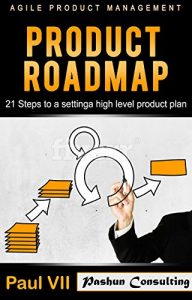Agile Product Management and Creating a Product Roadmap - Just Got Easier
Thank you and congratulations on taking this class, “Product Roadmap: 21 Steps For Setting Product Plans and Release Goals”.
In this class, you will be givenproven tips to set excellent overarching goals for your product as part of an agile scrum team.
I know you will get value from this class as it gives you a full introduction to the concept of the product roadmap. I then walk you step by step through the steps involved in creating a productroadmap. Following this, I give you tips for coming up with managing and using a product roadmap in your team or business from the ground up. Along the way, I give you plenty of examples and give you best practices for product roadmap creation within agile scrum. In this class, you will learn
•A brief recap of Agile Scrum and how it is used to create high quality products
•What is a Product Roadmap?
•What does a real product roadmap look like and how is it used to visualize a
strategic plan as well as map out product releases?
•A high-level outline of how the product roadmap is used to carry out the strategic
plan fora product
•A step-by-step example of how to create a product roadmap for a real product
•Concise techniques for improving your product roadmap
So let’s get started and let me teach you how to create and improve your product roadmap.
Table of Contents
Introduction
Chapter 1: What is a Product Roadmap?
Step 1: Make the Backlog Actionable
Step 2: Choose the Appropriate Format
Chapter 2: What Does a Real Product Roadmap Look Like?
Chapter 3: Implementing the Product Roadmap
Step 3: Accomplishing the Work
Step 4: The Sprint Goal
Step 5: The Daily Scrum
Step 6: The Sprint Review
Step 7: The Sprint Retrospective
Step 8: Product Backlog Refinement
Step 9: Progress Monitoring
Step 10: Measuring Sprint Progress
Step 11: Team Velocity
Chapter 4: A Step-by-Step Example
Chapter 5: Concise Techniques for Improving Your Product Roadmap
Step 12: Focus on Values and Goals
Step 13: Develop a Good Strategy
Step 14: Build Logic into Your Plan
Step 15: Keep Everything Simple
Step 16: Collaborate on the Roadmap
Step 17: Be Selective about Features
Step 18: Only Show Dates When Necessary
Step 19: Quantify your Roadmap
Step 20: Make the Scope Flexible, Not the Budget
Step 21: Routinely Examine and Modify your Roadmap
Conclusion
Preview Of ‘The Scrum Master Mega Pack’
Check Out My Other Books



